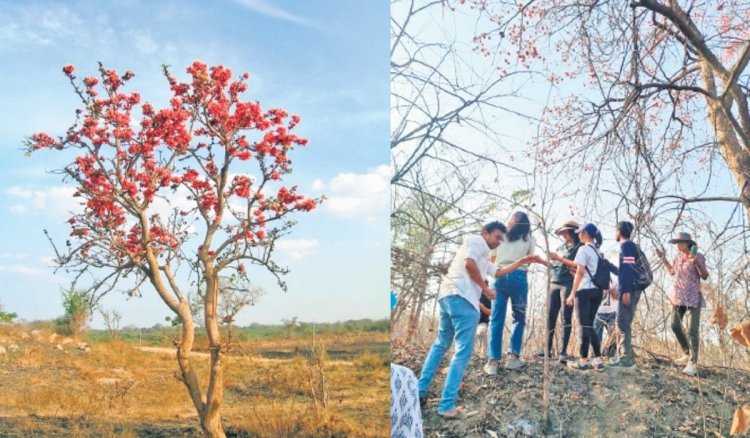Hyderabad's 'Palash ki Talaash' walk celebrates nature's wonders
Umbva phutay, tesu phulay”… is a line from a song in Sanjay Leela Bhansali’s upcoming film Heeramandi. Written by Amir Khusro, it heralds the season of spring when tesu, or the palash flower, is in bloom. Palash, a native Indian flower that has deep meaning in the very nodes of Indian culture—in its stories, songs, and iconography. Every year, in the weeks preceding Holi, a walk—Palash ki Talaash—is held in Hyderabad to see the beauty of these wonders in their natural habitats. Set against the dry and arid landscape of the Deccan, the portmanteau of the colours of the flowers—red, vermilion and bright orange—is a sight to behold. It is little wonder that writers from Kalidasa to Tagore have written about their beauty. The walk started on a high note, with a sighting of the migratory Rosy Starlings that winter in the Indian subcontinent and return to Central and West Asia. As the palash trees are rich in nectar, these tiny birds seek sustenance and shade on their long journeys. Interest

Umbva phutay, tesu phulay”… is a line from a song in Sanjay Leela Bhansali’s upcoming film Heeramandi. Written by Amir Khusro, it heralds the season of spring when tesu, or the palash flower, is in bloom. Palash, a native Indian flower that has deep meaning in the very nodes of Indian culture—in its stories, songs, and iconography. Every year, in the weeks preceding Holi, a walk—Palash ki Talaash—is held in Hyderabad to see the beauty of these wonders in their natural habitats. Set against the dry and arid landscape of the Deccan, the portmanteau of the colours of the flowers—red, vermilion and bright orange—is a sight to behold. It is little wonder that writers from Kalidasa to Tagore have written about their beauty. The walk started on a high note, with a sighting of the migratory Rosy Starlings that winter in the Indian subcontinent and return to Central and West Asia.
As the palash trees are rich in nectar, these tiny birds seek sustenance and shade on their long journeys. Interestingly, they start their journey around the same time as the palash starts to bloom in Deccan and follow the trail of the blooming flowers in central India and north India before departing the country for the season. The walk started by two teachers, Sadhana Ramachander and Kobita Dass Kolli, who teach gardening and nature awareness at the Vidyaranya School of Hyderabad, brings enthusiasts, families, children, and even pets to the outskirts of the city, where the flower is found in abundance.
For Ramachander, who grew up in the Warangal city of Telangana, this is a homecoming of sorts.
“I grew up seeing the palash trees and find their sculpted appearance very artistic, as well as their claw-like, velvety orange-black flowers. And then there’s plenty of bird and insect activity going on. To see it in full bloom against the arid Telangana landscape is a heady sight,” she says. In Telangana, it is called the modugu flower and is deeply rooted in the consciousness of people. During Shivratri, the flowers are not picked. Instead, a sari is placed under the trees in the days preceding the festival, and only those flowers dropped by the wind or the birds are used for worship.
The uses of palash are multifold: while the flowers are used in colours, the leaves are used in making plates, and the bark is used in many Ayurvedic and Unani medicines. The flowers are also used to make the red dye with which Buddhist monks colour their robes. The trifoliate formation of the leaf is supposed to represent Lord Vishnu in the middle, Lord Brahma on the left, and Lord Siva on the right. For Kolli, the palash is a harbinger of life.
She adds, “Its unique keel petal requires birds to make an effort to reach the hidden nectar, thus aiding pollination. They are practically the first blooms of ‘Vasantha’ with generous amounts of nectar, therefore a key supporter of biodiversity in the arid season and important to the semi-arid ecosystem since they can survive the harsh conditions.”
What a palash in full bloom signifies is the circle of life. Intrinsically tied up with the rituals of the land, they are eternal, majestic, silent, and historical, and they inspire omniscient emotions that move everyone from a common bystander to great poets.
It is walks like these that enable city-dwellers to pause and ponder, to rest and recharge, to notice the invisible and pay attention to the silent wonders surrounding us. From a year-old baby to silver-haired citizens, children to Leo, the Labrador, walk was essentially a labour of love and community.
Deeply rooted to nature, the rustle of leaves in the breeze, the chorus of birdsong, the scent of wildflowers—each sensory experience serves to ground us in the present and simply be in the moment.
Yoga instructor Harshita Soni puts thing into perspective when she says, “I had read about the palash in a recipe book but had never seen it. I often mistook the African Tulip tree commonly seen in the city to be palash. I think if there were an Oscar for flowers, it would go to palash.”
















